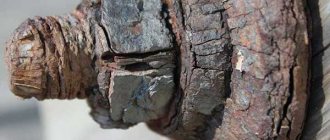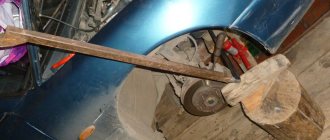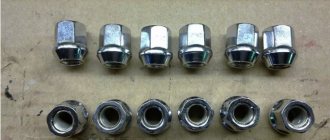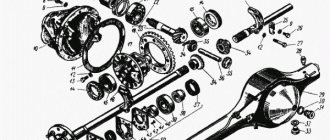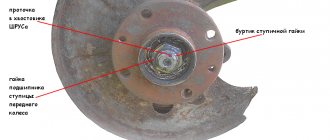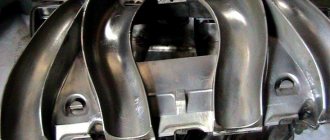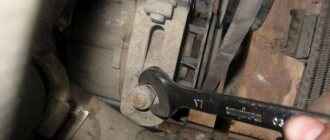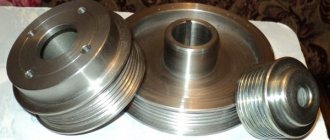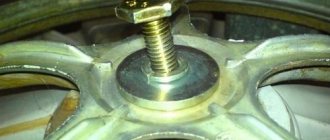What is strictly forbidden to do (use of force)?
The main mistake of many beginners is a thoughtless approach to twisting and the use of “force” methods.
Remember, in order to unscrew a stuck element, it is important to be patient and not rush. Solving the problem requires a consistent and measured approach
Haste in resolving an issue can cause many problems.
Thus, car owners often rush to unscrew a rusty bolt and tear off its upper part.
The result is drilling out the broken product, which will take a lot more time.
In addition, the result of haste may be damage to nearby nodes with the key, which will lead to the need for additional investments.
Before starting work, draw up an action plan, and then begin to implement it.
If you work in a hurry, the total cost of time and money may be higher. Moreover, there are enough methods to quickly unscrew a rusted nut or bolt. We will talk about them below.
Unscrew the broken bolt
In order to remove the broken bolt with an extractor, you will need to use a drill. You also need to take drills, dies for taps, and a strong core. In the broken “culprit” it is necessary to make a hole, the diameter of which should not exceed the diameter of the thread of the broken bolt.
The extractor has a reverse thread.
An extractor is screwed into the hole. When you screw the extractor, or rather its reverse thread, into the broken bolt, you remove it along with the latter.
If the bolt breaks off and it is possible to reach it, then you need to restore the geometry of what is left of it. Use a file or coarse sandpaper. Then you need to carefully paint the surface. Otherwise, the drill will always walk along the rest of the bolt and it will not be possible to make a hole strictly in the center. It is also necessary to maintain alignment. The hole should be drilled as close to the center of the bolt as possible.
It is necessary to start drilling with a small diameter drill and clearly position the hole in the center. The centered hole can be expanded very easily. The diameter of the extractor must be taken 1 mm larger than the diameter of the hole
It is important not to drill through the hole so that the extractor has something to grab onto.
The extractor must be screwed into the recess of the bolt surface. Then the extractor must be installed in the recess and struck with a hammer, trying to hammer into the hole like a nail. After this, it should remain in the recess.
It is necessary to clamp its head with a die and rotate it in the direction of unscrewing the bolt itself. You need to rotate the die slowly and as carefully as possible. By crashing into the bolt, the extractor tightens it as much as possible and transfers its torque to the broken “culprit”. In turn, the torque will unscrew the broken bolt.
Ramp
Replacing the cathode collector on a VAZ 2110
The ramp is removed as an assembly with the fuel pressure regulator:
- It is necessary to disconnect the vacuum hose from the regulator.
- Using 2 open-end wrenches 17, unscrew the fittings securing the gasoline supply pipes to reduce pressure.
- Disconnect the ramp voltage connector.
- Using a screwdriver, unscrew the screw of the bracket for fastening the gasoline supply and outlet pipes and disconnect it.
- Using a No. 5 hexagon, unscrew the 2 screws for fastening the ramp.
- Pull the ramp in the axial direction of the injector from the seat, remove the ramp towards the left side of the hood.
Note: follow the direction of travel of the vehicle.
Replacement cathode collector for VAZ 2110
- Unscrew the nut from the left intake manifold bracket and loosen the lower bolt.
- Remove the bracket from it.
- Perform the same operation with the right bracket and remove it.
- Unscrew the 2 nuts from the eye stud.
How to unscrew a stuck nut on a wheel
Before starting this difficult work, you need to prepare:
- 6-sided spanner,
- hammer,
- chisel,
- liquid for dissolving rust (WD-40, kerosene, diesel fuel, hydrogen peroxide and others).
You can unscrew the nut only if you damage the joint (sticking) of both parts with rust. The “blurred” rust will allow the cutting to be affected and the nut will turn. Let's look at several ways to unscrew a nut without cutting:
You can unscrew the nut only if you damage the joint (sticking) of both parts with rust
Method 1 - moisten the fasteners with WD-40 or any other preparation that has a high property of fluidity and dissolution of the formed oxide. After waiting 20 minutes for the liquid to “work”, tap with a hammer along the entire perimeter of the nut. Using a hexagon, start unscrewing it back and forth. Method 2 - try tightening the wetted nut first
In this case, the softened layers of rust will crumble, carefully swing the nut in a back-and-forth motion and begin to unscrew. Method 3 - if the nut does not give way, you can try the tapping method, in which the resulting homogeneous layer of rust is destroyed. Using a hammer, apply sharp but gentle blows to the side edges of the nut, being careful not to bend the bolt.
Repeat the process several times. Make sure the fasteners are loose. After the next wetting with the preparation, the nut can be safely unscrewed.
Method 4 - if the previous manipulations did not bring the expected result, you will have to destroy the stubborn knot: the nut can be cut to the ground. To do this, in the direction of unscrewing the nut, apply strong blows with a hammer to a chisel placed at an angle to the side edge of the nut; if the nut is accessible, you can saw it along the axis with a hacksaw or grinder; if sawing is impossible (there is not enough room for access), try drilling out the nut, using a drill, if it is impossible to work with a drill, then use a well-sharpened chisel to cut grooves up to 1 mm deep on the edges of the nut. Gradually go deeper into the body of the nut along the grooves. A deformed nut can be easily unscrewed, but you will have to use a new one during the restoration process.
Method 5 - There is another very unpopular method, since careless handling can damage the paintwork of the car. It is known that metals expand when heated and can “drop” their oxide
This work must be done carefully and quickly, so as not to heat the bolt or the entire connection, but only the nut. For heating, you can use available means - from a match to a blowtorch and boiling water. You can apply this method to the entire threaded connection. To do this, you need to heat the threaded connection several times to +230C and cool it. A change in temperature will contribute to the destruction of oxide in the threads. Lubricate with any penetrating lubricant (kerosene, diesel fuel, etc.). Unscrew the nut.
Grinder or cut
Perhaps the very last thing, if all else fails, and even if the edges are torn off, then the only thing to do is “cut”! This is usually done with a grinder; you can use a hacksaw if you can’t get to it with a grinder (or it’s dangerous). There’s really nothing to comment on here, we cut it off, remove the remains, and install a new bolt (nut).
I’ll finish here, I would like to note that in 80% of cases WD-40 (or the analogue that I showed you) helps. In other cases (catalyst, manifold, catalytic converter), heating helps. Tested – 100%!
Read our AUTOBLOG, subscribe to updates, it will be interesting.
Similar news
- Flame arrestor device. Photo of the car version. And …
- Replacing the catalyst with a flame arrester. The main pros and cons...
- Car muffler device. In simple words with photos. Read...
Add a comment Cancel reply
Why is a rusty bolt or nut difficult to unscrew?
Any metal fastener inevitably undergoes corrosion and rust over time. The process is accelerated if the bolts and nuts are often exposed to aggressive environments:
- contact with water;
- interaction with chemicals, including detergents;
- street dirt, dust, caustic salts - they accelerate the corrosion process.
Despite special protective coatings against rust, if the surface of the fastener has been even slightly damaged, then over time the process of destruction is inevitable.
After some time, the rusted bolt must be removed and replaced, but a problem often arises - it will not unscrew. Due to the oxidative processes of the metal, rust grows on fasteners and parts and the surfaces “grab” together. If this process develops at the location of the bolt thread, then the situation becomes even more difficult.
Replacing the ramp on a VAZ 2110
The ramp is always removed together with the fuel pressure regulator:
- Disconnect the vacuum hose from the regulator.
- When unscrewing the fitting on the fuel supply pipe, use an open-end wrench size 17.
- Remove the ramp voltage connector.
- Also unscrew the screw securing the gasoline supply pipes and then disconnect it.
- Then, using a hexagon, unscrew several screws from the ramp mounting.
- The ramp is removed along the direction axis of the nozzle and removed from its usual place.
- Then the substitute is removed, you need to unscrew the fastening on the left side of the intake manifold and slightly loosen the lower bolt.
- Remove the bracket itself.
- Now you should remove the right bracket in the same way.
- Unscrew several eye nuts from the stud.
Preparing for work
It is not always possible to find the necessary equipment for such work on hand, especially at home. You can use improvised tools that almost every owner has.
Before you begin to unscrew the bolt, cover the bolt with a rag soaked in kerosene.
The longer the rag lies on it, the easier it will be to unscrew.
If you don’t have time, you can treat the bolt with pure kerosene or WD-40 lubricant. It is necessary to tap the bolt with a hammer, then spray with WD-40 or kerosene.
After 1-2 minutes, you need to tap the bolt again and start unscrewing it. If there is no grease and kerosene, you can use brake fluid or ordinary vinegar.
Heat
Heating is very effective in such difficult areas as, say, a manifold, muffler or catalyst. The bolts really stick there due to high temperatures. You won't be able to unscrew them with WD-40, and it's difficult to use acid under the car. Therefore, here you need to act using the “wedge-wedge” method. That is, if it’s stuck due to heating, then you need to unscrew it through it.
If the mount is small, then it can be heated with a regular soldering iron and held for about 10 - 15 minutes. However, if the case is severe, this will not help. An open flame burner works great here - special cans are sold. The bolt heats up almost to a red color, the metal expands (the “sticking” effect is weakened), now it needs to be cooled sharply (preferably with a penetrating compound like WD-40), it turns out like a mini blow, you can safely unscrew it.
Acids
This is also an effective method, however, it is not as safe. For example, if a bolt or nut is located next to rubber products, it is better not to use it, because the acid can destroy soft materials.
Usually high concentrations of sulfuric acid are used; if the bolt is simply oxidized and not stuck, then just drop it on the thread - the oxides will come off and after a few hours everything will unscrew perfectly. If you need to unscrew a “difficult case,” then a plasticine rim is made around the cap and a few drops of acid are added there, to enhance the effect, a piece of zinc is also placed (a galvanic couple is created). After 12 - 24 hours, almost any bolt, even a stuck one, can be unscrewed. However, it is not always possible to make such a side from plasticine.
Prevention
Judging by the information given above, unscrewing a rusted bolt or nut is not difficult, but it takes a lot of time and effort.
It’s easier to prevent problems and take into account a number of recommendations. Below are just a few of them:
Coat the nuts that hold the muffler with an anti-corrosion compound before tightening. After this, treat the product with grease (for greater effectiveness, add a little graphite to the composition). This prevents sticking. Wash the engine and the car as a whole from time to time. Dust and dirt that accumulate on the surface accelerate the process of corrosion. Buy only high-quality fasteners made of durable metal
When choosing, pay attention to such a criterion as strength class. Try not to skimp on nuts and bolts, because using cheap products leads to a number of problems in the future
At the same time, the question of how to unscrew a rusty fastener can become very relevant. Remember that we are talking about reliability and durability, savings on which are inappropriate. Do not abandon your car in a nearby or open parking lot. Storing a vehicle in a closed garage is an opportunity to reduce the risk of corrosion on connections. The negative impact of rain or cold negatively affects the condition of the body, as well as the vehicle’s fastenings. When performing work, use only high-quality tools - gas or ring wrenches, as well as special heads. Of course, this will require more money to purchase, but it is more convenient to use such a tool, and the mounts themselves last longer. A good tool allows you to solve two problems - maintain the integrity of the nut and protect it from damage, and also stretch the fastener with the required torque.
Replacing the collector on a VAZ 2110 with your own hands
To replace the device yourself, you need to:
- Place the car in the garage.
- Open the hood and hang a special lamp with lantern protection.
- Before carrying out all work, be sure to drain all the antifreeze from the tank.
- Remove the battery.
- Remove the pipe from the vacuum booster.
- Disconnect all hoses from the ramp pressure regulator cover.
- Disconnect the throttle sensor and its cable.
- Unscrew the clamp on the air supply pipe a little, then disconnect it completely.
- Then you need to remove the fastening from the throttle pipe and ventilation of gases from the crankcase.
- All hoses are removed in pairs.
- The clamp on the crankcase ventilation should be loosened.
- Then it is removed altogether.
- Do the same with all other hoses to make further work easier.
It is worth remembering here that the receiver can only be removed together with the throttle assembly. You should also disconnect all adjacent hoses and chips from it, and of course loosen the fastenings. Do not forget about the places where the device is attached; if the replacement is being carried out for the first time, it is better to notice these places so as not to confuse anything. This is all necessary to correctly install the new part. All small fastening elements should be placed in one place so as not to be lost.
After all this, unscrew several nuts securing the receiver and the supply tube bracket. The receiver can then be removed and the gasket removed from it.
How to unscrew a stuck bolt
Car repairs are often made more difficult due to corrosion and oxidation of fasteners. For example, during assembly at the factory, the master did not treat the threads with lubricants, and during operation water got in there. As a result, the bolt seemed to be stuck tightly, but such a nuisance can be dealt with in several ways.
Unscrew a rusty bolt or nut by tapping
When you tap, rust and scale come off the bolt, making it easier to unscrew. The operation is carried out with a hammer, turning with a special tool to create torque.
Be careful, as you can damage the product and have to drill it out. After removing the fastener, it is cleaned of rust and treated with graphite lubricant
If available, place a boot on the connection.
Using solvents
In the arsenal of any experienced car enthusiast there is always a set of liquids to combat rust and other deposits. They mainly use WD-40 with good penetrating ability into micro-gaps, the cost of which starts from 100 rubles. Along with it, brake fluid, white spirit, kerosene, and Coca-Cola are used. Unlike WD-40, other liquids have a weaker effect, and it is better to pour them into a container and place the stuck compound in it for greater effect.
If the bolt is stuck on the front pillar, the solvent can be carefully poured into the “glass”. The main thing is not to damage the rubber bands on the racks, otherwise you will have to change them.
Moisten a rag with any product, wrap it around the nut and leave it for a while. Then they tap the bolt to destroy the softened rust and begin to unscrew it.
Thermal method
When the solvent does not cope with the task, you can try exposure to fire and cold. Any large auto or hardware store sells a gas torch; it is used to heat the bolt until it turns bright orange. Then they cool it with machine oil and try to weaken it. If the attempt fails, the process is repeated again.
This method does not always help, and if it is close to the paintwork or fuel tank it is very dangerous. When working with a gas burner, you must follow fire safety rules and do not use it if you do not have a fire extinguisher at hand.
Use freezing sprays to preserve the bolt for later use. But such reagents are used mainly by professionals, since in domestic conditions this is a costly and unprofitable matter.
WD-40 and other penetrating agents
It’s really a very effective thing, I recommend it to everyone. Especially if your bolts or nuts are not subject to temperature stress, and water has entered the threads. This is a very good penetrating substance, just treat the area and wait half an hour. A bolt or nut will yield in 80% of cases.
The disadvantages of this method include the price of the final drug, which is quite high. Although there are now a lot of different analogues, they do not completely repeat the final formula. By the way, you can make a pretty good analogue of WD-40 with your own hands , according to my recipe. Watch a short video, it's useful.
The problem of rusted bolts and nuts
It is important to remember that the fasteners in question are made of metal. This means that the bolt and nut are susceptible to corrosion.
Products used in cars are resistant to moisture, rain, fog or snow. All this can become a catalyst for the formation of rust and problems with twisting products.
No less difficult is created by sand, salt or chemical compounds that are sprinkled on the road surface in winter.
Special reagents have a negative effect on body metal and accelerate the formation of rust on the threaded elements of the car.
As for sand, it carries certain risks at any time of the year - winter and summer.
Small grains of sand hitting a metal surface leave microcracks on it, which only accelerates the corrosion process and complicates the maintenance process for the car owner.
Another risk factor is the vehicle’s cooling system, which may lose its seal during operation.
If water is flooded inside, if a leak occurs, it gets into the joints and accelerates the process of scale formation and problems with unscrewing.
No matter how the car owner protects the car, each of the listed factors has a negative impact.
That is why it is important to know how to unscrew a rusty nut or bolt without creating additional problems for yourself (for example, damaging adjacent and expensive elements of the vehicle)
Physical methods
Actually, there are only two of them, but be careful, you can break the edges and make it even worse, so:
- Tapping - we take an ordinary hammer and simply tap the nut or bolt (not too hard, so as not to dent it), often this is enough, oxides, rust or even “sticking” comes off and the connection can give way. If this does not happen, try to concentrate the blow, take an “impact screwdriver” and direct the force on the nut or bolt head. THERE IS NO NEED TO HIT THE THREAD, IF YOU BRING IT, IT WILL BE EVEN WORSE, then just cut it off.
- Lever or shoulder. Often it is not possible to unscrew it with a key; there is simply not enough lever force. It is enough to lengthen the handle, take a longer “knob” or put a metal pipe on the key, the connection can unscrew. However, be careful, the edges can be torn off!
Prevention of the problem
If the bolts rust and cause a lot of inconvenience when unscrewing, you should put an end to this problem. Professionals advise:
- Be sure to coat all fastening points of parts with special silicone grease before tightening them. Thanks to this, metal fasteners are protected from corrosion for a long time.
- It is advisable to carry out preventive inspections of car parts or plumbing from time to time. You should not start the process if you notice slight rust on one of the fasteners. It is always easier to replace fasteners and parts at the initial stage of corrosion than to fight rust when it has completely corroded the metal.
- Fasteners should be tightened in accordance with the tightening degree of similar threaded connections.
If you use high-quality fasteners, their service life will be long.
If, having previously selected the necessary tools, you use one or several of the methods listed, then the rusted bolt will definitely give in. But it is better not to reach extreme situations and carry out periodic technical inspections.
Previous entry Fasteners used when installing and assembling a toilet Next entry Fastenings for navigators in a car
Effective ways to unscrew a rusty bolt or nut?
If we consider more effective ways to combat rust, it is worth highlighting the following methods.
Heat.
From the physics course we know that metal tends to expand as temperature increases. This feature can be used to solve the problem.
To unscrew a rusty nut, warm it up thoroughly, and then immediately try to unscrew it.
It is important to act quickly here so that the metal product does not have time to cool down. The essence of the manipulation is that due to uneven heating, the rust is deformed and has less restraining force
Heating can be carried out in any available way. This could be a gas burner, a candle, a lighter, or even a soldering iron.
You can also use a blowtorch or other device.
When using this technique, be careful and remember the contraindications. In particular, heating is not recommended if wood or paintwork products are located in the joint area.
In this case, the part will be damaged and you will have to spend money on replacing it.
Tapping.
You can unscrew a rusty nut or bolt using the traditional method - by tapping around the perimeter of the part.
Mechanical impact on each side allows for greater deformation, which contributes to the scattering of rust.
While tapping, be careful not to damage the edges of the nut. Otherwise, the task of unscrewing will become more difficult.
Twist.
You can also go the other way. First, tighten the nut (bolt) with maximum force, and then try to rock the connection and dislodge the rust layer in this way.
If the manipulation is successful, unscrewing the nut or bolt will not be difficult.
Wax cup (difficult, not practical, but possible).
This technique cannot be called popular, but in terms of effectiveness it is in no way behind its “competitors”.
The algorithm of actions is simple. Make a cup-shaped shape from plasticine or wax so that its sides are above the level of the nut (about 2-3 mm).
Then dilute the sulfuric acid, pour the liquid into the prepared cup and add a little zinc. This chemical combination provides a galvanic effect and the ability to unscrew the part.
Destruction.
If none of the above methods produces results, and the upper part is broken or severely deformed, there is another solution - breaking the bolt and drilling it out of the vehicle part.
Here, to complete the work you will need a hand or electric tool, as well as a set of drills of a suitable diameter.
Before drilling, place the drill bit in the center of the bolt and hit it with a hammer. This is necessary to deepen the product in the central part to a certain depth.
First, work in small increments and make sure that the drill enters exactly in the central part (tilts to the left and right are prohibited).
Start with a small diameter drill and then move on to a larger piece.
When choosing a drill, pay attention to two criteria - price and country of origin. Please note that high quality products cannot be cheap, because they are made from hardened steel and sharpened in a certain way.
Please note that high quality products cannot be cheap, because they are made from hardened steel and sharpened in a certain way.
At the same time, special drills do an excellent job with aluminum, cast iron and other materials (including brittle ones).
To ensure correct drilling, use special lubricants, which can solve several problems at once - protect the drill from strong heat, cool the metal and lubricate the drilling elements. As a result, the whole process becomes easier.
How to unscrew a hairpin: 25 effective ways and techniques
How to unscrew the pin?
Let's consider several methods, taking into account the condition of the stud and the available tool. How to unscrew a stud by its threaded part
If the stud is long enough and a threaded part for 2 or more nuts is available, then we use one of the following methods:
- screw on the nut, screw the second one all the way into the first one (it is advisable to use tall nuts), then unscrew the stud with a mechanic’s tool (wrench or other);
- use a special tool - a hairpin driver, suitable for the size of a hairpin or a universal one.
An eccentric pin driver is convenient and effective - the greater the force applied to it, the stronger it clamps the pin with the eccentric notch.
How to unscrew a stud if there is only thread available for 1 nut? In this case, at least 4 methods are available:
- cut the nut on one side with a hacksaw (the direction of the cut is along the axis of the threaded part), screw it onto the stud, clamp it with a pipe wrench so tightly that the threaded part, choosing a gap in the cut, tightly grips the stud, direct the force in the direction of unscrewing;
- screw the nut onto the thread, weld it to the stud (for example, with a semi-automatic welding machine) and unscrew it with a wrench (or a head with a knob);
- screw the nut onto the thread, drill a recess in the end of the stud (approximately half the diameter of the stud), drive a TORX socket (E-profile, or another similar one with longitudinal ribs) into this recess and unscrew it by the shank of the socket (you can use your second hand to help with this) with an open-end or socket wrench applying force to the nut in addition to the main force on the torx);
- Using a hacksaw for metal, make a cut at the end for a flat screwdriver, with which you can remove the pin.
In the screwdriver method, a large version or a power version with a T-handle is better suited for this purpose.
How to unscrew a hairpin by its smooth cylindrical part
If only the smooth part of the stud is accessible (for example, the threaded part is broken), then the following techniques are applicable;
- clamp the cylindrical part in a suitable tool (pliers, a pipe wrench, a small vice, a clamp, or the like) and apply force in the direction of unscrewing;
- weld a metal rod to the broken end by welding as a T-shaped handle;
- put on a nut of a slightly larger diameter, weld it to the stud in a circle and unscrew it with a wrench;
- use a square washer as thick as a nut or more, with an internal diameter the same size as the diameter of the cylindrical part of the stud (ideally, if the washer fits on the cylindrical part of the stud with interference), cut it on one side in the same way as the nut in the previous subsection, put it on the stud, clamp pipe wrench and unscrew;
- use a die (the one used for cutting threads), turning the end of the pin to a square of the desired size;
- use a pin driver;
- Using a hacksaw for metal, make a cut at the end for a flat screwdriver, with which you can remove the pin.
In some cases, if possible, to enhance the impact, simultaneously with applying force to a screwdriver or wrench, you can use a second tool (pipe wrench, pliers, etc.), clamping them on the smooth side surface and acting in the direction of unscrewing.
How to unscrew a broken hairpin
If the pin is broken and there is no part protruding above the surface, then you can unscrew it in the following ways:
- using a semi-automatic welding machine, gradually and carefully “build up” a couple of centimeters (if the end of the stud is within the reach of the welding wire) and then unscrew the “build up” using a clamping tool;
- use a special tool - an extractor (looks like a tap, the working part is conical, the thread direction is opposite to the thread of the stud): align the protruding end of the stud with a file (or saw off evenly with a hacksaw), tap exactly in the center, drill a hole of the required diameter along the axis of the stud and depth (approximately 2/3 of the length of the working part of the extractor), insert the extractor and rotate with force until the pin is unscrewed;
- preparation with drilling as in the previous method, only use a tap on the left thread of the stud (if the stud is in the right direction) - when the tap, cutting the thread, rests on the bottom of the drilled recess in the body of the stud, the fragment is often unscrewed;
- drill out the center of the stud, choosing the diameter in such a way as not to touch the threaded part of the socket, and then remove the remaining metal of the stud;
- Drill out the broken part of the stud and the threaded socket on a drilling machine or with a hand drill with a drill of a larger diameter for the repair stud.
Using the method of drilling a recess and driving a Torx tip into it carries the risk of strengthening the wedge in the threaded socket due to the expanding deformation of the stud walls. Taking into account possible complications, we will not recommend it in this situation, despite the fact that it can be used in a limited manner, with certain conditions.
Cases when it is difficult to unscrew a bolt
Threaded connections have the unpleasant property of losing their mobility over time. To avoid this, the fasteners to be connected are made of different metals, for example, steel and brass. Or the mating pair is made of stainless steel. But that rarely happens.
Basically, steel fasteners are used in mechanisms, units and metal structures. If it is in a humid environment, then over time corrosion processes begin, significantly complicating dismantling when the need arises. There may be several reasons why hardware (metal products) do not want to unscrew.
Edges torn off
During assembly, each fastener must be tightened with a certain force - sufficient to ensure the strength of the connection. By applying excessive force, you can break the threads of small-sized products - from M3 to M12.
This is no longer a problem for larger fasteners, so many men tighten the bolts and nuts with maximum force. This is bad for any hardware. When the time comes to disassemble the connection, parts damaged during assembly can greatly complicate the task: a screw or screw with a twisted spline, a bolt or nut with torn edges.
Most often, a hexagon turns an open-end wrench, which has only two working planes. Therefore, if possible, you should always use a spanner, socket or special tool.
But if the edges have already been “licked”, they do not always help. The tool rotates, but the fasteners remain in place.
Rusted nut
Corrosion processes always lead to the appearance of rust, which tends to swell and increase in size. As a result, the thread jams. Unscrewing a rusty nut becomes problematic. Auto mechanics, mechanics, and craftsmen working at home face this problem.
In addition, the nut can rust not only in the thread area, but also in the area where it contacts the product. Sometimes even the puck doesn't help. The connection becomes monolithic over time. It takes a lot of work to take it apart.
The bolt has become stuck over time
There is often a situation where fasteners on mechanisms last for years before disassembly. During this time, it manages to stick so strongly to the body of the structure that the strength of the connection can be compared with a welded one. The most difficult to unscrew in these situations are the hardware that is exposed to heat.
Car enthusiasts and car service mechanics know how difficult it is to unscrew the exhaust tract fasteners on a muffler or resonator. Sometimes any means of moving a stuck bolt are powerless. All that remains is to destroy the connection using one of the mechanical methods.
Self-replacement
Replacing the exhaust manifold of a VAZ 2110
- the car needs to be driven into the garage;
- hang a lamp with a safety light under the hood;
- before starting repairs, antifreeze must be drained from the tank;
- disconnect the battery terminals;
- take it out;
- put on a rack;
- disconnect the vacuum booster hose from the receiver;
- also disconnect the hoses of the electric pneumatic valve cover and the ramp pressure regulator;
- disconnect the chips of the throttle sensor, idle air control;
- disconnect the throttle valve cable;
- loosen the clamp on the air supply hose to the air flow sensor housing;
- disconnect it;
- loosen the clamps for attaching the hoses to the throttle pipe and ventilation of crankcase gases on the cylinder head cover;
Replacing the cathode collector for a VAZ 2110
- remove the hoses in pairs;
- loosen the crankcase ventilation hose clamp;
- remove it from the throttle assembly;
- In the same way, carry out further work with the coolant inlet and outlet hoses.
Note. Use a 13mm socket to make the work easier, unscrew the 2 nuts from the throttle assembly from the studs. The throttle assembly is attached to the receiver.
- loosen the clamp;
- disconnect the adsorber purge hose;
- remove the throttle assembly;
- remove the sealing gasket.
Note: these nuts must be unscrewed using a number 13 wrench.
The receiver must be removed together with the throttle assembly. In addition, it is necessary to disconnect all inlet and outlet hoses and idle speed sensor chips from the assembly. Carefully check to make sure that all fastenings are completely loosened.
Note: it is recommended to remember all the attachment points; you can use threads of different colors. To prevent incorrect connections during assembly.
Note: place the parts in a container so that during assembly you do not have to look for missing spare parts.
Unscrew the 2 nuts for attaching the fuel supply and outlet pipe bracket to the receiver. The same - 1 nut for fastening the receiver to the bracket, 5 pieces for fastening to the intake manifold. Remove the receiver, remove the gasket.

